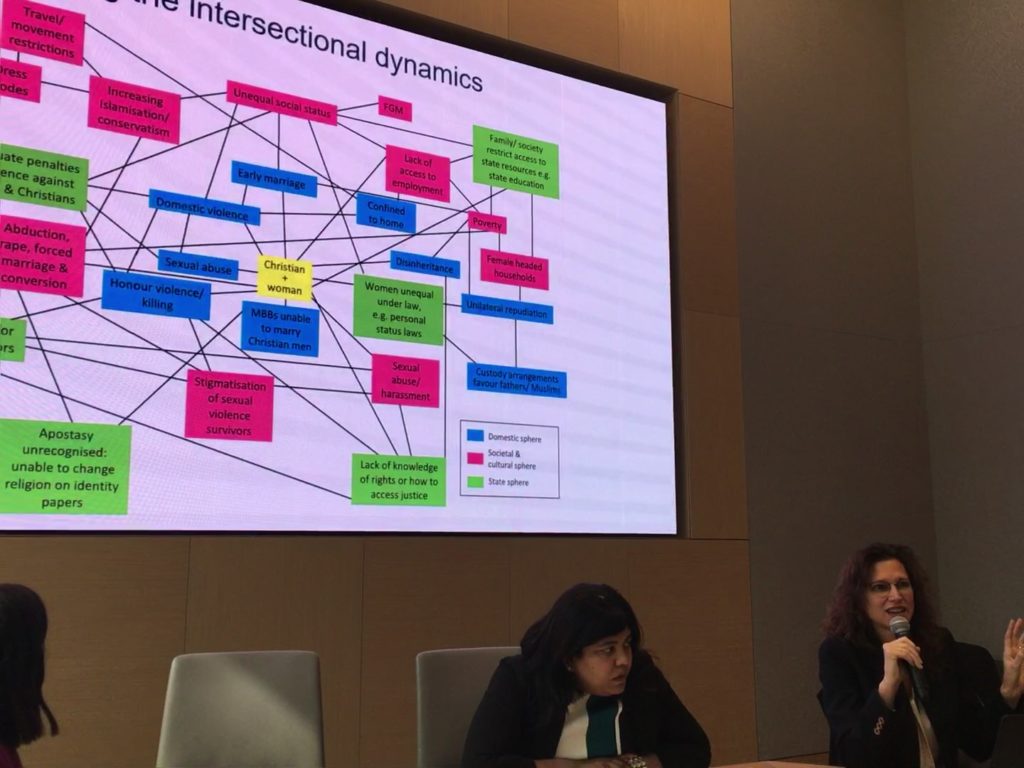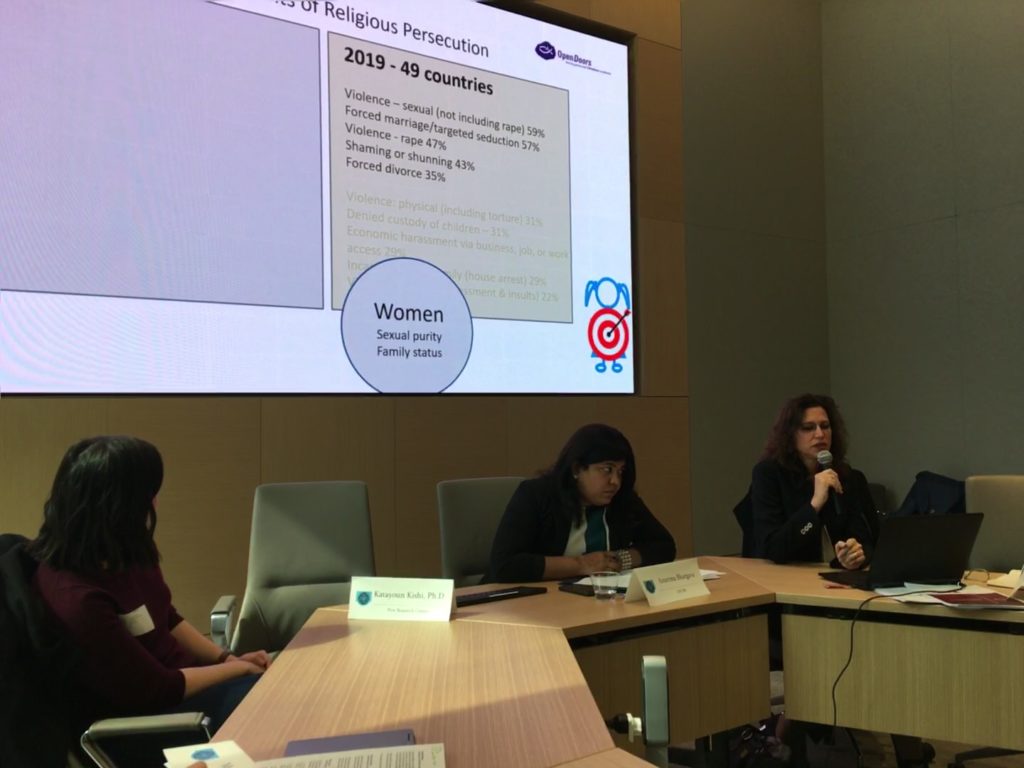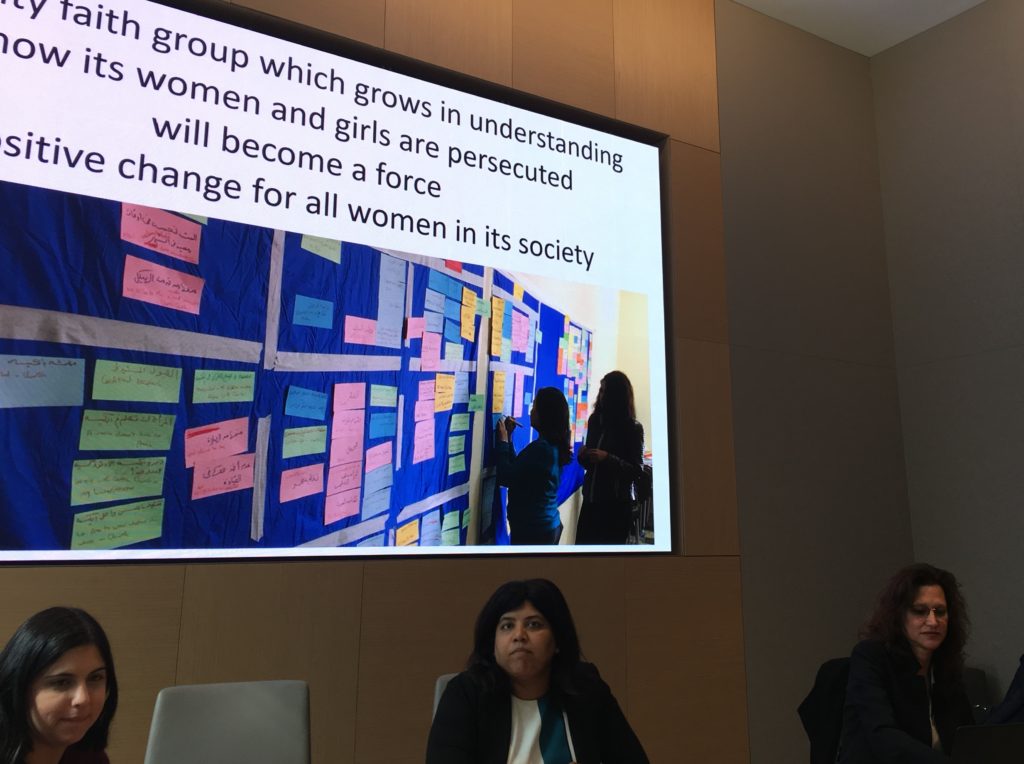
She is a woman who can be identified only as “Z”, for her security. She is a Christian in India, a country that is overwhelmingly Hindu. And she is a lawyer defending women and youth from exploitation by landlords and employers, so she was pleased when she got the opportunity to put a client’s case to a local official.
“When I went to his office, he was sitting with his legs up on his desk.
“‘How old are you?’ he asked.
“‘What’s my age got to do with anything?’ I responded.
“‘We don’t want to see you again around here….’ “
Such stories of intimidation are common at the UN’s Commission on the Status of Women (CSW), the annual UN women activists’ summit, which continues this week.
CSW is the main inter-governmental body exclusively dedicated to the promotion of gender equality and empowerment of women globally; it documents the reality of women’s lives throughout the world, and shapes global standards.
The story of Z was one heard at a parallel event hosted by the Salvation Army and co-ordinated by the World Evangelical Alliance, one of hundreds of NGO side events during the summit.
But despite the pervasive presence of the current buzzword ‘intersectionality’ (“a framework that attempts to identify how interlocking systems of power – eg. race, class, gender – impact those most marginalized in society”), the intersection of gender and religion is barely mentioned in UN documents and declarations, such as the Convention on the Elimination of All Forms of Discrimination against Women (CEDAW).
And members of the UN NGO Committee on the Freedom of Religion or Belief (FORB) confirm there is almost no research on this particular intersection, i.e., how far women find themselves marginalized due to their religious belief.
This seems all the more surprising when 83% of global women identify with a religious faith, according to the Pew Research Center. Its researcher, Kayatoun Kishi, speaking at another CSW side event, welcomed the gender-specific persecution research done in the past 2 years by the World Watch Research Unit of Open Doors International, saying it seems to be the only research looking at ‘gendered’ persecution for religious belief in such detail. Yet millions of women face this double discrimination, for their faith and their gender, every day – if not triple discrimination, when their poverty adds to the mix.
“I wish I could tell you how rare, how exceptional Z’s story is…But alas, I can’t”, said Helene Fisher, gender persecution specialist of Open Doors, after Z told of women such as Rani, a young Indian woman who’d dreamt of economic independence. A friend had promised Rani a job, but then raped her and threw acid in her face. “Now all I dream of is to sleep; I can’t close my eyes any more”, Rani confided to Z.

Ms. Fisher stressed that stories such as Z’s and Rani’s populate the detailed research on persecution that women (and men) experience for their Christian faith, which Open Doors now conducts every year based on its World Watch List of the 50 countries in which it’s most difficult to live as a Christian.
It’s based on in-depth questionnaires filled out both by relevant sources inside countries, as well as experts on the countries who are based outside them, and so might feel freer to be more candid. Ms. Fisher and her colleague Elizabeth Miller then analyse the results with a focus on gender.
Interestingly, although the respected Pew Center does not do such detailed research on gender issues, the research Ms. Kishi shared – alongside Open Doors – echoes the latter’s findings.
For instance, in the latest Pew research (2016), women are targeted for their faith in 42 out of 77 countries where, to enforce religious norms, violence is used against religious minorities.
This bears out the just-published Open Doors gender research, which shows that the most-cited pressure experienced for their faith reported by Christian women is sexual violence/assault (excluding rape, itself the third most reported pressure).
Sexual violence, often by family or community and used as a means of power and control over women, was reported by 59% of the 50* countries.
“Christian women and girls are subjected to physical violence. Initially they are usually emotionally pressured by immediate family (e.g. husband, in-laws, parents). Physical abuse starts gradually until finally they are regarded as social outcasts by family and community. This makes them vulnerable and victims of sexual oppression”.
Open Doors 2019 report, concerning Nepal
Pew Research
Pew Research in 2016 found that governments regulate the wearing of head-scarves or head covering for women in 54 countries. Separately, it found that women were harassed for violating religious dress codes in 18 countries (including violation of ‘secular’ dress code, such as the ‘burkini’ ban in France).
An example is Sudan. “Female Christians… are forced to dress like Muslims”, the Open Doors’ 2019 report said. “Those arrested for ‘indecent dressing’ often face groping and humiliation during interrogation”.
Open Doors researchers also write that, “for instance, the presence of a cultural disdain for [minority] Christians and their perceived association with loose ‘Western’ morals (such as in dress code) can perpetuate the false idea that it is permissible to assault a Christian woman. This could in turn serve to focus the choice of victim as, say, a woman whose head is not covered by a hijab. Where all women may be at risk of sexual assault, marginalized Christian women may be even ‘more so’ ”.
In 61 of the 192 countries surveyed by Pew for 2016, women are at least 2% more likely than men to have a religious affiliation. In the remaining countries, Pew says, women and men display roughly equal levels of religious affiliation because, in many cases, nearly all the population identify with some religious group. In no countries are men more religiously affiliated than women by 2% or more.

Yet “It’s so, so rare to hear about a woman’s right to freedom of religion or belief: this right is pretty much ignored in the context of gender justice [around the world]”, admitted members of the US Commission on International Religious Freedom (USCIRF), also attending the CSW in New York.
USCIRF policy and strategic approaches
In an attempt to remedy this, USCIRF had produced a report in July 2017 “Women and religious freedom: Synergies and opportunities.” This aimed to better understand the synergies between religious freedom and the rights of women and girls, and to address the widespread misperception of a clash between these two human rights.
It concluded that women’s rights and religious freedom are not competing objectives: “When religious freedom is respected, religious actors have the capacity to be mobilized to respond to violations of women’s rights through advocating respect for the dignity and integrity of [all]”.
Following on from its report, in May 2018, USCIRF produced a policy focus on “Women and religious freedom”, which states, under its two strategic approaches: “When a government engages in, or tolerates religious freedom violations against a particular community, the women and girls of that group experience increased vulnerability to other violations and limited access to protection”.
USCIRF’s policy concludes: “The priority theme for CSW 2019 is social protection systems, access to public services and sustainable infrastructure for gender equality, and the empowerment of women and girls. Religious freedom is key to fully addressing this priority, as women’s access to both social protection systems and public services is often predicated on their ability to safely navigate the public sphere, an ability severely hampered by religious freedom violations. This is especially true in the case of women from marginalized religious communities, who face dual obstacles in accessing public services”.
While acknowledging that it won’t be possible to get it included for this year’s CSW, the meeting organized by the UN NGO Committee on the Freedom of Religion or Belief ended with a note to try to introduce a resolution – recognizing that women’s rights and religious freedom are mutually reinforcing, and not contradictory – into the 2020 CSW.
Meantime, USCIRF also lists as key areas for its co-operation with the international community:
Child, Early & Forced Marriage (CEFM) and related restrictions:
It says this “is, in many contexts, given religious justification despite the harm incurred and the lack of full consent. While many legislatures have passed laws to counter CEFM, challenges remain, including lack of enforcement in rural communities and the prevalence in some countries of unregistered “religious marriages” conducted outside the legal sphere. The issue is further complicated in situations of sectarian tension or conflict, where governmental or societal actors seeking to preserve religious demographics may interfere with the human rights of inter-faith couples and limit women’s rights to freely choose their spouses. For example, India has witnessed mob violence and forced annulments of marriages arising from fears of so-called “love jihad”, or allegedly coercive seduction and conversion of non-Muslim women by Muslim men, while Burma’s Interfaith Marriage Law restricts the ability of Buddhist women to marry men of other religions”.
Early and forced marriage is the second most-reported pressure experienced for their faith by Christian women, in 57% of the countries surveyed in the latest report from Open Doors.
“Many are also forced into marriage with non-Christians. The fact that there are laws which permit under-age marriage in some states (as well as the existence of cultural and religious norms that discourage girls from going to school) only contributes to this problem”.
Open Doors 2019 report, concerning Nigeria
Sexual and Gender-Based Violence (SGBV):
“Victims of religious discrimination or marginalization are uniquely vulnerable to sexual and gender-based violence, including sexual assault, rape”, USCIRF says.
Rape is the third most-reported pressure experienced for their faith by Christian women, in just under half of the 50 countries surveyed in the latest Open Doors report. In Libya, for example, “It has been reported that rape is sometimes used as a form of punishment [for conversion to Christianity]”, the report says.
As USCIRF’s policy focus goes on to explain: “[Minority religious] communities also have extremely limited access to legal recourse. Governments and non-state actors sometimes perpetrate or tolerate SGBV to intimidate or drive out disfavored religious groups, as in the cases of Yazidi women in ISIS-controlled territory…and religious and ethnic minorities, including Rohingya Muslims and Kachin Christians, in Burma.
“In addition, legal frameworks on SGBV and CEFM in many countries still reflect an uneasy tension between religious, customary, and secular sources of law, especially in countries that have dual legal systems, like Indonesia and Nigeria”, the policy says. “States in which religious authorities wield extensive influence may face difficulties in implementing otherwise clearly-drafted legislation on these issues. In Pakistan, for example, national laws on CEFM and SGBV are often ineffectual in the face of opposition from local religious leaders”.
Despite acknowledgement of the difficulties, both parallel events ended on a positive note: that where religious freedom for all, including women, is fully practised, economic empowerment follows more quickly and all citizens are enabled to contribute effectively.

*In research for the 2019 World Watch List, 49 countries returned data specific to women, 46 to men